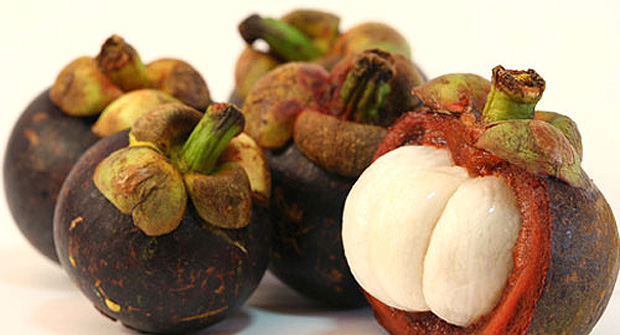The mangosteen fruit ( Garcinia mangostana ) is a species of trees of the genus Garcinia, family of Clusiaceae. It is an evergreen tropical originated in the Sunda Islands and of the ' archipelago of the Moluccas.
The tree grows up to a maximum height of between 7 and 25 meters, and has a bark dark brown verging on black. In the Philippines, most of the mangosteen harvest comes from Sulu, Zamboanga and Davao del Norte.
The fruit, edible, is round in shape, with a diameter of about 5-7 cm, does not necessarily require fertilization and in this case has no seed; when unripe is has a light green color, then the peel of the fruit changes color to deep purple in ripening.
From the point of view of botanical pulp is an aril (pulp removed from the skin, but adhering to the seed) which is divided into 4-8 lobes or segments edible, fragrant and creamy, milky white, the vague taste of peach and lychee. Within two months of training the fruit that darkens gradually increases its size, the pericarp is relatively hard for the whole stage.
The membrane below the skin, which envelops the aril and the seed, contains acids polyphenolic, among which the tannin and the xanthone which ensure a certain astringency that discourages any infestations of insects, and infections of fungi, viruses and plant bacteria , prevents also the predation of animals. The change of color (from pale green to dark purple) and the simultaneous slight softening of the pericarp are part of the natural aging process, and indicate that the fruit has concluded its development and can be consumed.
~~~
~~~
Use as fruit
The mangosteen fruit is eaten as a tasty fruit, the shell is very tough and bitter. The flesh has a pleasant acid taste, is a cross between grape, pineapple, grapefruit and peach. A mangosteen fruit contains up to 5g fiber. From the whole fruit puree is usually a manufactured - in a similar way are also unpeeled oranges made into marmalade.
Present in some fruits cores actually apply as inedible, but are cooked by some people to be eaten or roasted.
In vitro studies following effects of natural xanthones have shown in the mangosteen: anti-inflammatory, antimicrobial, antifungal, antiviral, anti-SCLC (lung), tumor-inhibiting, ulcer-resistant, protects against liver damage, anti-viral rhino, allergy-resistant.
The tree grows up to a maximum height of between 7 and 25 meters, and has a bark dark brown verging on black. In the Philippines, most of the mangosteen harvest comes from Sulu, Zamboanga and Davao del Norte.
The fruit, edible, is round in shape, with a diameter of about 5-7 cm, does not necessarily require fertilization and in this case has no seed; when unripe is has a light green color, then the peel of the fruit changes color to deep purple in ripening.
From the point of view of botanical pulp is an aril (pulp removed from the skin, but adhering to the seed) which is divided into 4-8 lobes or segments edible, fragrant and creamy, milky white, the vague taste of peach and lychee. Within two months of training the fruit that darkens gradually increases its size, the pericarp is relatively hard for the whole stage.
The membrane below the skin, which envelops the aril and the seed, contains acids polyphenolic, among which the tannin and the xanthone which ensure a certain astringency that discourages any infestations of insects, and infections of fungi, viruses and plant bacteria , prevents also the predation of animals. The change of color (from pale green to dark purple) and the simultaneous slight softening of the pericarp are part of the natural aging process, and indicate that the fruit has concluded its development and can be consumed.
~~~
~~~
Use as fruit
The mangosteen fruit is eaten as a tasty fruit, the shell is very tough and bitter. The flesh has a pleasant acid taste, is a cross between grape, pineapple, grapefruit and peach. A mangosteen fruit contains up to 5g fiber. From the whole fruit puree is usually a manufactured - in a similar way are also unpeeled oranges made into marmalade.
Present in some fruits cores actually apply as inedible, but are cooked by some people to be eaten or roasted.
In vitro studies following effects of natural xanthones have shown in the mangosteen: anti-inflammatory, antimicrobial, antifungal, antiviral, anti-SCLC (lung), tumor-inhibiting, ulcer-resistant, protects against liver damage, anti-viral rhino, allergy-resistant.



No comments:
Post a Comment